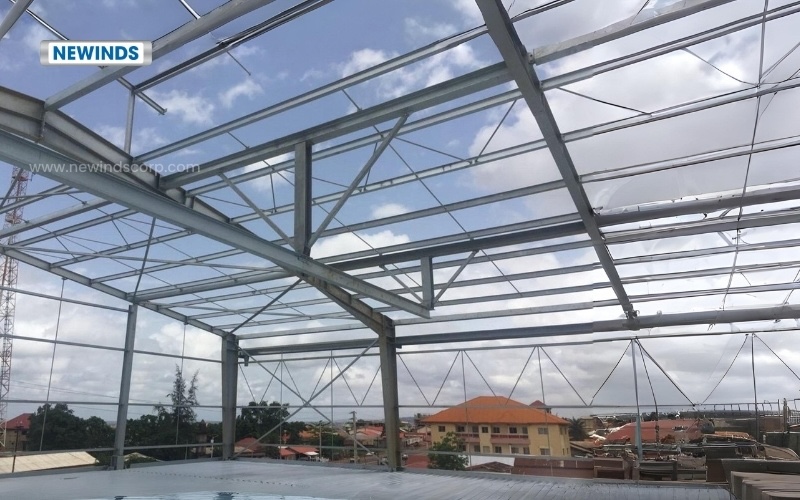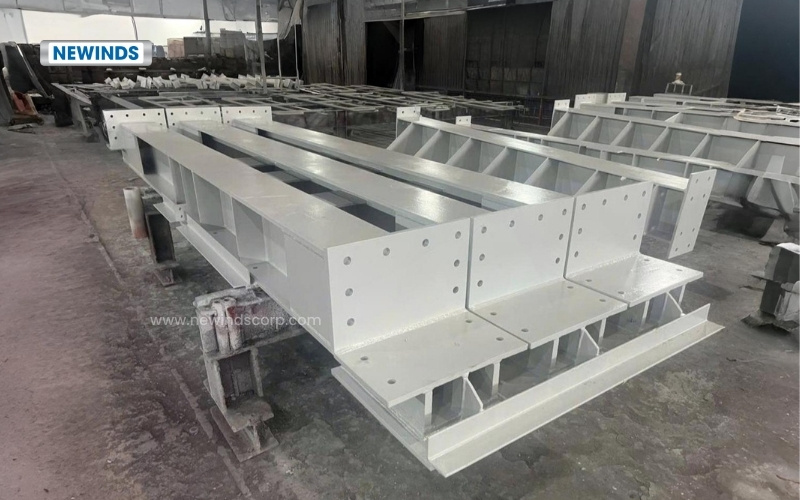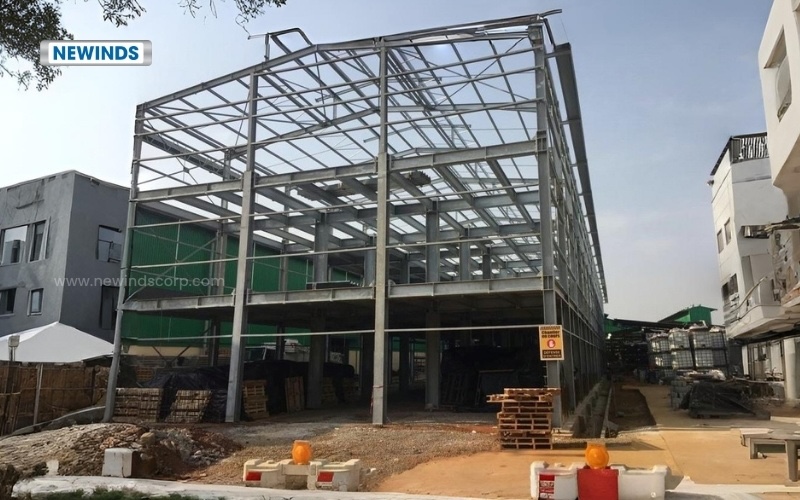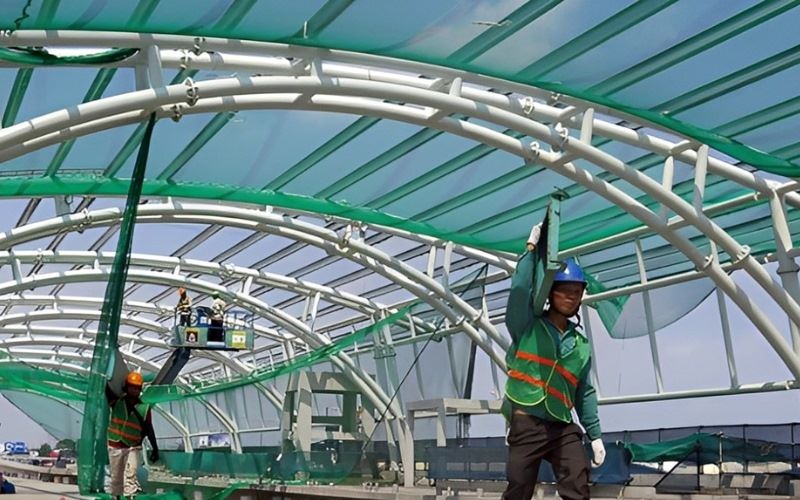Steel structure brings strength and versatility to modern construction and helps shape today’s construction landscape. Let’s explore their key features, pros and cons, as well as common real-world applications.
What is Steel Structure?
Steel structure is a building system made up of structural steel members that are connected together to support loads and ensure overall stability. This type of structure is widely used due to its high strength, reliability, and consumption of fewer raw materials than alternatives such as concrete.
Depending on the project, structural steel can be fabricated in various shapes, sizes, and thicknesses through hot- or cold-rolling processes. Typical profiles include I-beams, hollow structural sections (HSS), bars, angles, and plates.
What are the five types of steel structures?
The increasing demand for steel structure construction requires fabricators to be flexible in creating various types to meet specific building needs. However, in general, steel structures can be categorized into five main types:
- Portal Frame Structures
- Beam and Column Frame Structures
- Truss Structures
- Arch Structures
- Grid Structures
How is the Steel Fabrication project done?
Step 1: Project Initiation and Planning
A steel structure project begins with a thorough analysis of requirements and site conditions to confirm feasibility. The fabricator then delivers a detailed plan covering fabrication, logistics, costs, and schedule, with a contract signed once both parties agree on the terms.
Step 2: Steel Structure Fabrication
The steel fabrication process begins with advanced machinery to precisely produce all necessary components. The main stages include:
- Cutting & Bending
The process begins with cutting raw steel sections to exact design specifications using advanced CNC, plasma, or laser cutting technology. These methods ensure superior accuracy and minimize material waste. The steel is then bent to the required angles or curves, ensuring that every part fits snugly during assembly.
- Assembly & Welding
After cutting and shaping, the parts are assembled into subframes or complete sections. Welding is performed using automated or semi-automatic systems, with the assistance of skilled welders when necessary. This step ensures strong, even joints, maximizing the strength and structural integrity of the steel frame.
- Surface Treatment
The assembled steel sections are thoroughly surface treated — typically through sandblasting, shot blasting, or acid pickling to remove rust, scale, grease, and other contaminants. This creates a clean, smooth surface, enhances coating adhesion, and prepares the steel for subsequent protective coatings.
- Protective Coatings & Galvanizing
To ensure long-term performance, steel is coated with multiple protective layers. Processes such as hot-dip galvanizing, painting, or powder coating are applied in accordance with international standards such as ASTM, AS/NZS, and EN. These coatings form a strong barrier that protects the steel from corrosion, even in outdoor, high-humidity or marine environments – significantly extending the service life of the structure.
- Quality Control
Before any component leaves the factory, it undergoes a comprehensive quality control process. This includes checking for exact dimensions, checking the weld (usually using ultrasonic or magnetic particle testing), and verifying the coating thickness. Only components that meet strict international standards are approved for delivery, ensuring safety and reliability after installation at the construction site.
Each stage of steel structure fabrication is closely monitored to ensure durability, strength, and compliance with international standards.
· Step 3: Transportation and Installation
All fabricated components will then be carefully packaged and transported to the construction site. Teams of skilled technicians will take care of every step so that the steel structures delivered to customers are guaranteed to be safe and of high quality, helping to complete the project on schedule.
5 REASONS WHY STEEL STRUCTURE IS THE BEST CHOICE?
- Optimized costs
Although the initial material cost is slightly higher than some traditional materials, the lightweight design of steel towers significantly reduces foundation requirements and labor costs. Therefore, in the long run, steel structures are considered a more cost-effective solution compared to other materials.
- Rigorous quality control
Factory-made steel ensures that every component is manufactured under strict quality control and regulations. During transportation, components are always safely stored by industry experts, ensuring consistent quality for projects.
- Eco-friendly
Steel structures, when dismantled, can be reused as whole members or recycled into new steel, helping reduce capital loss compared to concrete. At the same time, they also minimize construction waste discharged into the environment compared to concrete.
- Long-term durability
Regarded as a structural system with superior durability, steel frames can withstand harsh weather conditions such as high winds, earthquakes, and heavy snowfall. Unlike wooden frames, they are resistant to termites, mold and other biological influences, ensuring long-term performance.
- Architectural appeal
Steel is a versatile material that can be formed into a variety of shapes, making it a preferred choice for projects that require both functionality and architectural sophistication. Its sleek appearance and ability to support modern open space designs give architects the freedom to create visually impressive structures.
Common Applications of Steel Structure
- Residential and Commercial Buildings
From single-family homes to towering skyscrapers, structural steel forms the backbone of many structures. Its strength-to-weight ratio helps reduce foundation loads and allows for open, column-free plans, providing greater design flexibility.
- Infrastructure Projects
Steel is the preferred choice for many infrastructure projects, from bridges, railways, and overpasses to transmission towers, pipelines, ports, and underground structures. Its superior strength, fatigue resistance, and rapid erection process make it the ideal choice for projects that require long-term durability, safety, and reliability.
- Industrial Facilities
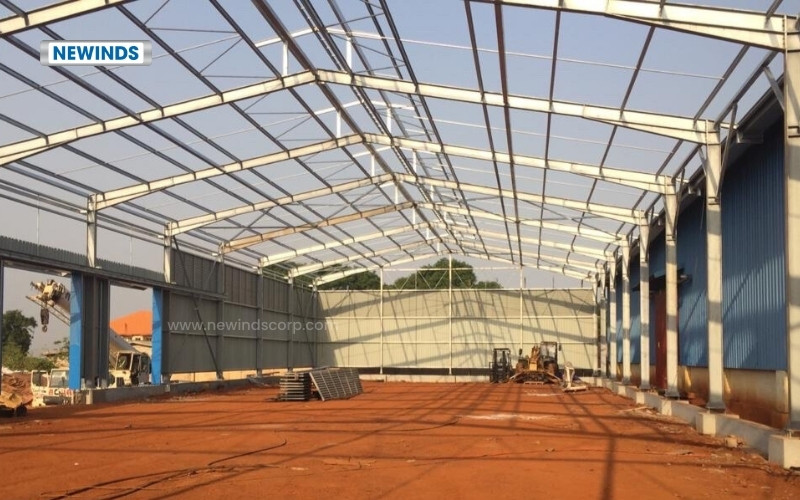
Factories, warehouses, power plants and industrial steel buildings often rely on steel structures due to their quick, cost-effective installation and ability to accommodate future expansion or process changes.
- Shipbuilding and Offshore Structures
In the marine industry, structural steel is the primary material for the hulls, decks and superstructures of ships, barges, and offshore platforms. Steel’s ability to withstand harsh marine environments, impact and corrosion makes it an indispensable material for safe and sustainable shipbuilding.
Steel structures are widely used in many different projects and their versatility ensures that more construction projects will adopt them in the future.
If you are in search of a high-quality steel structure fabricator, delivered with expert consultation and industry knowledge, we welcome the opportunity to discuss your needs.
Contact Newinds today to discuss your requirements
Email: sales@newindscorp.com
Phone/Whatsapp: +84 868 482 038
